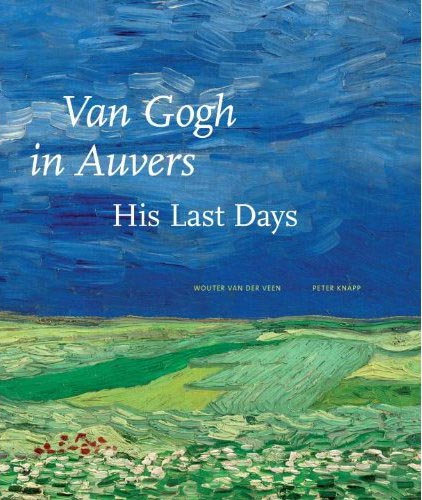
Published by The Monacelli Press
We are a culture obsessed with the secrets that will demystify genius. Convinced of its inherent oddity, we see its anomaly and resulting masterpieces as too fantastic to originate from a normal life. The fame that follows genius and its resulting celebritydom enchant us even more, sending our level of star-struck into the lull of proper swoon. The common assumption intrinsic to genius seems to be that of 'other', and to know the details about that every day life is an obsession of which we are almost all guilty. In Van Gogh in Auvers, His Last Days, Wouter Van der Veen attempts to untangle the myths that have grown like bacteria around the painter Vincent Van Gogh's enormous and hyperbolic legend. Van der Ween, who is scientific advisor at the Van Gogh Institute in Auvers-sur-Oise, wishes to distill the painter's history into the truths of the last months of his life based on the actual evidence of his words, his comrades, and his work. Throughout this eloquently arranged book, he highlights the need to constantly bring the focus of the painter's genius back to his work. The sheer scope of the artist's oeuvre, as well as a few choice incidents in the artist's life have allowed his legend and story to become so romanticized that the myth surrounding him has become a fluorescent hologram of an image hovering over the dark and definite lines of his true history. Van der Veen wants, above all, for the reader to realize that the romantic notions of Van Gogh's existence as being tortured was not always or exactly fate but often a choice.
While the writing is not spectacular, this is truly a painter's book. Van Gogh's energy and tenacious ethics are inspiring, his urgency contagious. I read it with a memory of my youth and want it back. Van Der Veen illustrates the tenuous, inextricable web of the brothers' mutual dependency and destruction as well as the delicate nature of their health and their fates. He discusses how Van Gogh had found much satisfaction in Auvers, had found his elusive health and, in June, had forward thinking plans for a future there, as expressed in his letters. Van Gogh had no desire for fame and recognition in an opulent sense; he in fact had the respect of his peers and savvily insured his family's fortune by keeping his enormous body of work together, rather than selling off bits here and there to be scattered about the world. He believed that since his brother Theo paid his salary, he thus owned all of the paintings. These observations refute the romantic notions of his depression or madness stemming from obscurity or poverty. Van Gogh was an artist who valued a connection to the land and his subjects, and the art world and its society seemed antithetical to those values. The Parisian suburb of Auvers-sur-Oise provided him with the natural landscape that was his ultimate vehicle, his inspiration, and often times his sense of peace. Van Der Veen wants the reader to realize the lack of tragedy at this point in Van Gogh's life, perhaps to foil the immense and mysterious tragedy that was his death. The author makes sweeping points and grand gestures as to the incredibly prolific and mostly positive last period of his life in audacious language and conclusion.
The format attempts to divide the book into the last part of the painter's life and his subsequent legacy. Throughout these different sections, large and colorful reproductions of the paintings and drawings are scattered to serve as concrete visual anchors to the text, while the text informs the reader about actual events taking place in the painter's life. This commentary also points to the evidence of artistic respect of other contemporary artists of the time, further debunking the partial myth of Van Gogh's endless suffering.
The middle section of the book is filled with detailed blurbs of the nuts and bolts of Van Gogh's painting. The writing here is often quite dry and academic and occasionally reads with the quality of being translated. This section of the book is somewhat monotonous to read through, yet Van der Veen obviously wishes to illustrate Van Gogh's path during his period in Auvers-sur-Oise visually. While these plates are vibrant, they, like all reproductions, are only a course shadow of the actual paintings. This section is also somewhat awkward in the sense that it is decorated with oddly chosen quotes from Van Gogh himself; while visually strong, the content here seems hastily chosen. Peter Knapp's art direction is elegant and reads much like an onion: the layers and sections of the book designed to form the whole of Van Gogh's last months. His subsequent propulsion into art history via the tireless efforts of his brother's widow, Johanna Bonger, seals his budding legacy into the halls of eternal fame.
Van der Veen's account relays the many facets and players involved behind his myth and his truth, and both have captivated the world for almost a century now. Author also indicates that the lauding of every single work Van Gogh did is often more worthy of the respective anecdote the work conjures and symbolizes rather than the artistic merit of the work itself. Yet the period in Auvers was so intense and concentrated that part of its beauty is the ability to see the artist's process, his attempts at experimentation and his failures. These last days were not the only time in his life during which these things occurred, yet it was this time that was the most concentrated, the most fervent, and the most distilled. Van der Veen wants the world to note that the popular concentration on Van Gogh's mental illness negates not only the artist's genius, but his tireless, fervent dedication, and the brilliant innovation of this particular individual.




















